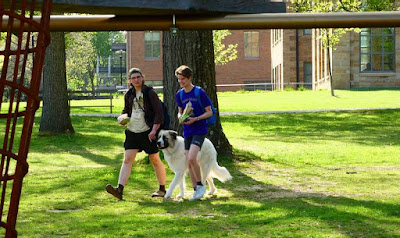Centerburg
Some of Knox County is home to commuters to Columbus. Overall it is very white, and rural. Driving through, one sees golf courses, beyond dilapidated barns, and Gadsden rattlesnake flags. It has been ridiculously Republican since 1920. Catholic presidential candidates were/are especially unpopular. Johnson had a landslide in '64, when the country thought the Republican candidate was crazy. Such discernment and acumen has evaporated and vanished.
Again, humour is where you find it.
Mount Vernon is the county seat, and only town in the county. Like so many municipalities, there is a war monument* in the center of Public Square. Ohio fought for the Union, and there is a tall pillar with a federal soldier high a top. The square has a traffic circle around it, and you see familiar buildings that are usual to find in a small town laid out in the XIXth century: city hall, a hotel, a former masonic building, and strangely—two tattoo shops. There are handsome storefronts nearby, but many are vacant.
This chimney is now an observation tower, and an exercise apparatus. It smoked from 1951 to 1977. It is the tallest structure in the county at 280', with a spiral staircase with a top deck half way up.
Pac-man art, Inky (cyan blue) and Clyde (orange).
There once was a Pittsburgh Plate Glass factory in Mt. Vernon. It has been demolished, and a town park has arisen, Ariel-Foundation Park. There are remnants of buildings, some are existent and purposed. There is some sculptures using the ruins. What is impressive are terraced mounds, and tall arbor vitae.This chimney is now an observation tower, and an exercise apparatus. It smoked from 1951 to 1977. It is the tallest structure in the county at 280', with a spiral staircase with a top deck half way up.
view from the Raskin Tower
view from the Raskin Tower
view from the Raskin Tower
The first private college in Ohio is Kenyon in Gambier. It was started to educate future Episcopalian priests, and until 1875 was the seat of the Ohio diocese. The earliest example of collegiate Gothic architecture was here. The campus has been selected on some surveys as the most lovely in Ohio. The 1869 Church of the Holy Spirit is beautiful, and with (my eyes) three studios of stained glass, it deserves a post of its own. I want to visit again.Paul Manship. "Indian Hunter" and "Pronghorn Antelope". 1917. 2002.
The original is at Amherst College Massachusetts. In 2002, two copies were cast, one went to Museum of Fine Arts Boston, and one here outside the dining hall. Manship was an influence to Art Deco style. He was influenced by archaic Greek art. I wonder, how many students realise any of that. There is also an outdoor bronze copy of Maillol's La Montagne on campus, and archaic Greek influence is more pronounced in Maillol.
_______________________________
*There are many monuments to the Union dead, and this one names it "The War of the Great Rebellion".










No comments:
Post a Comment